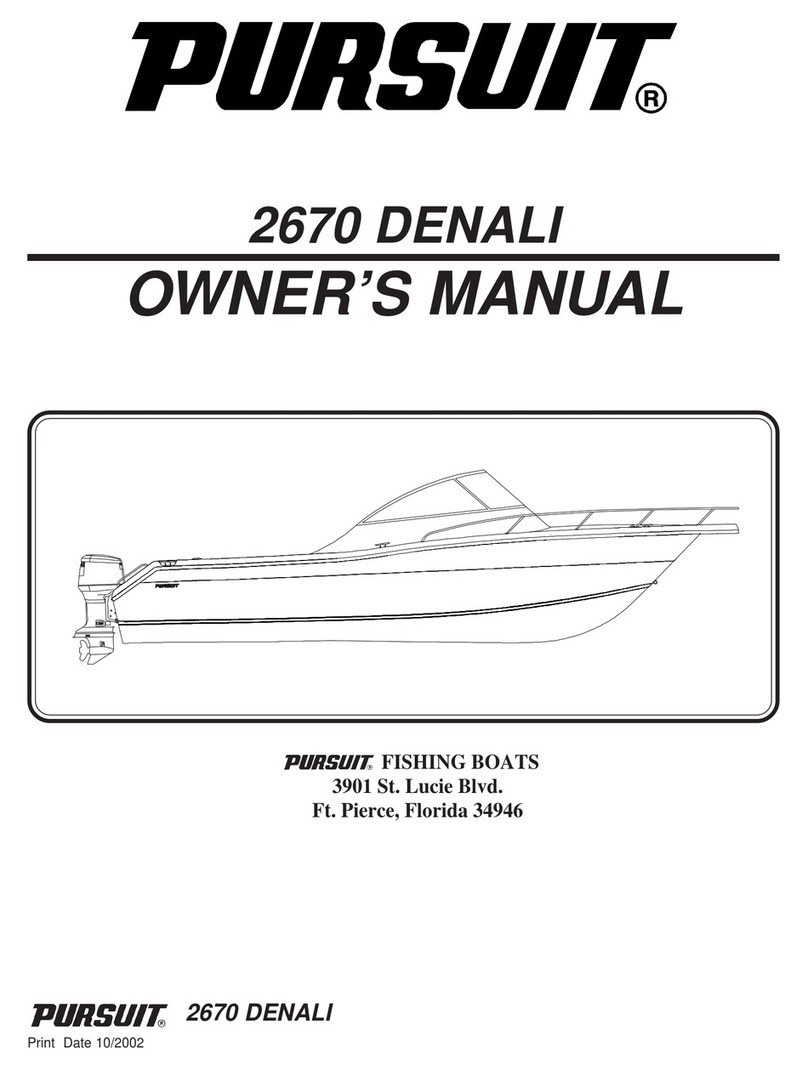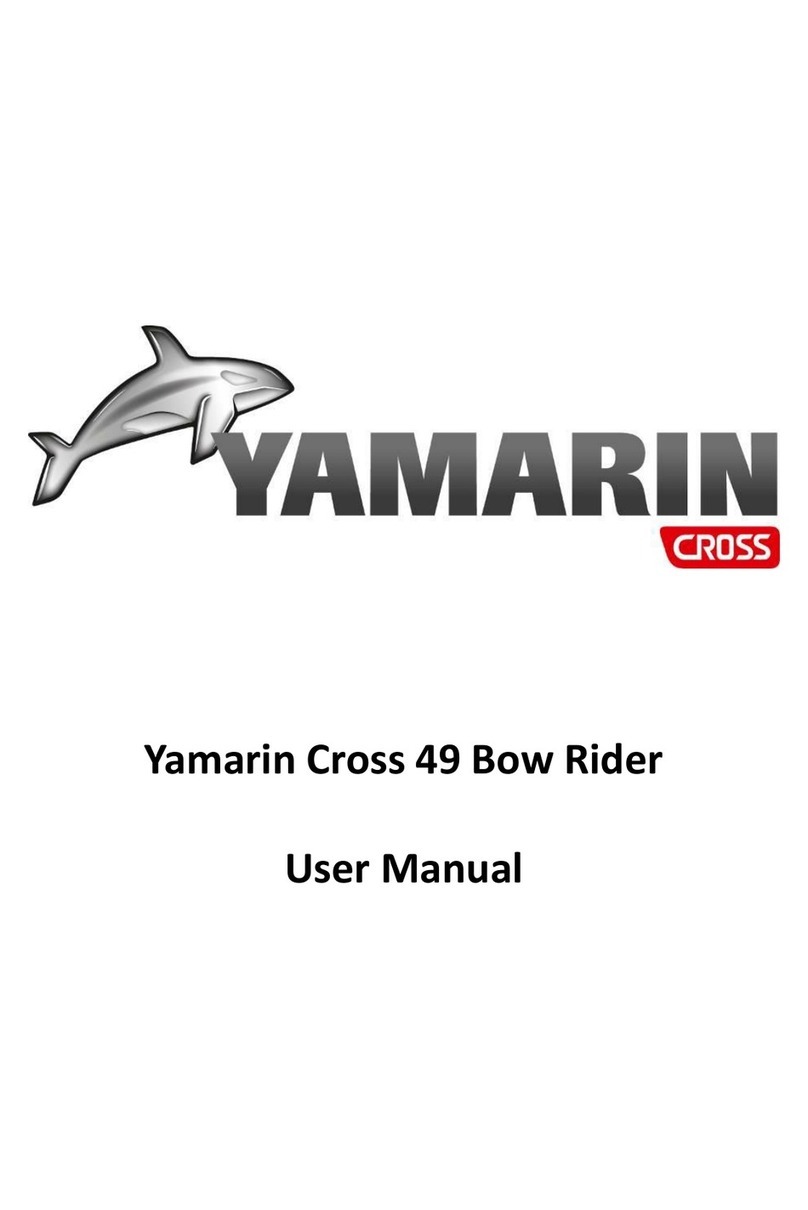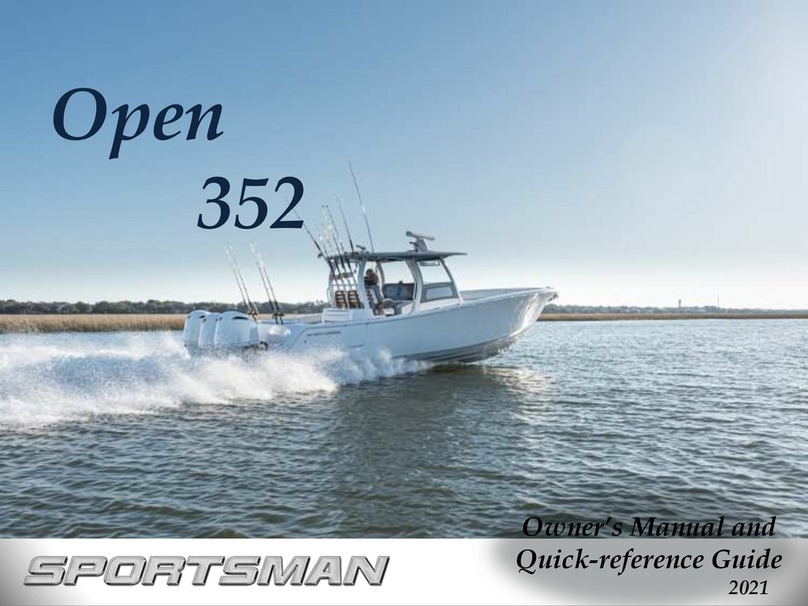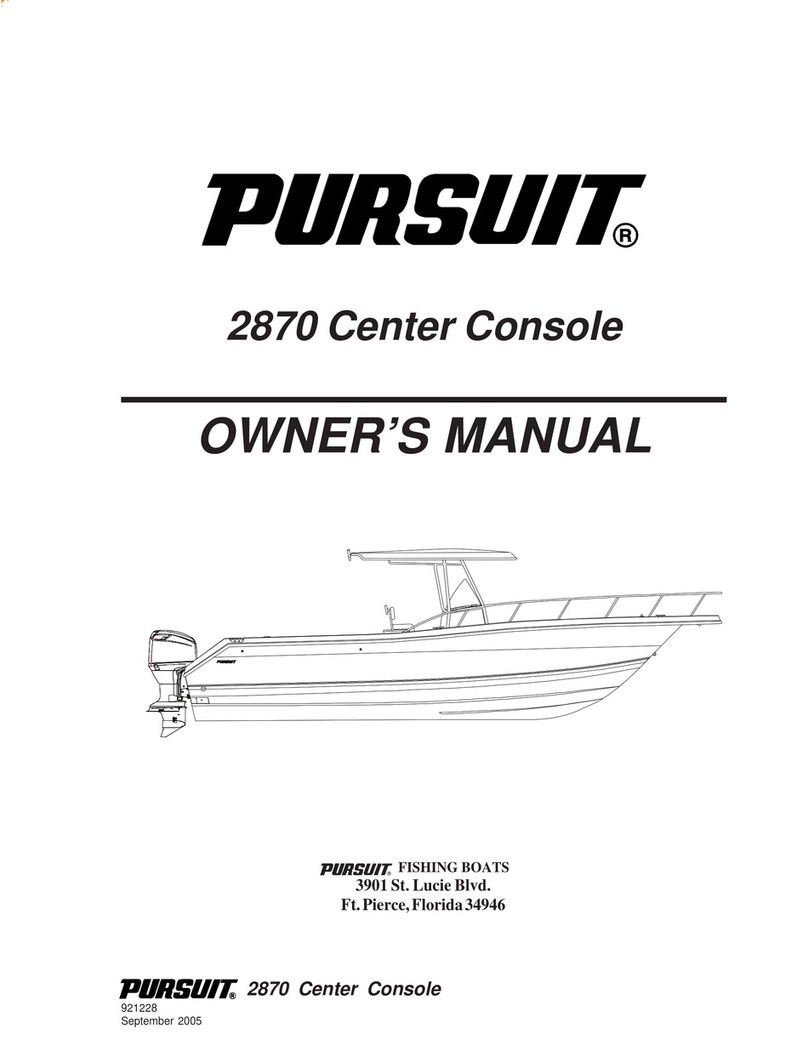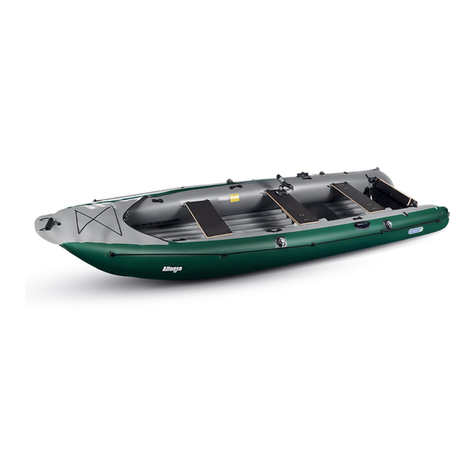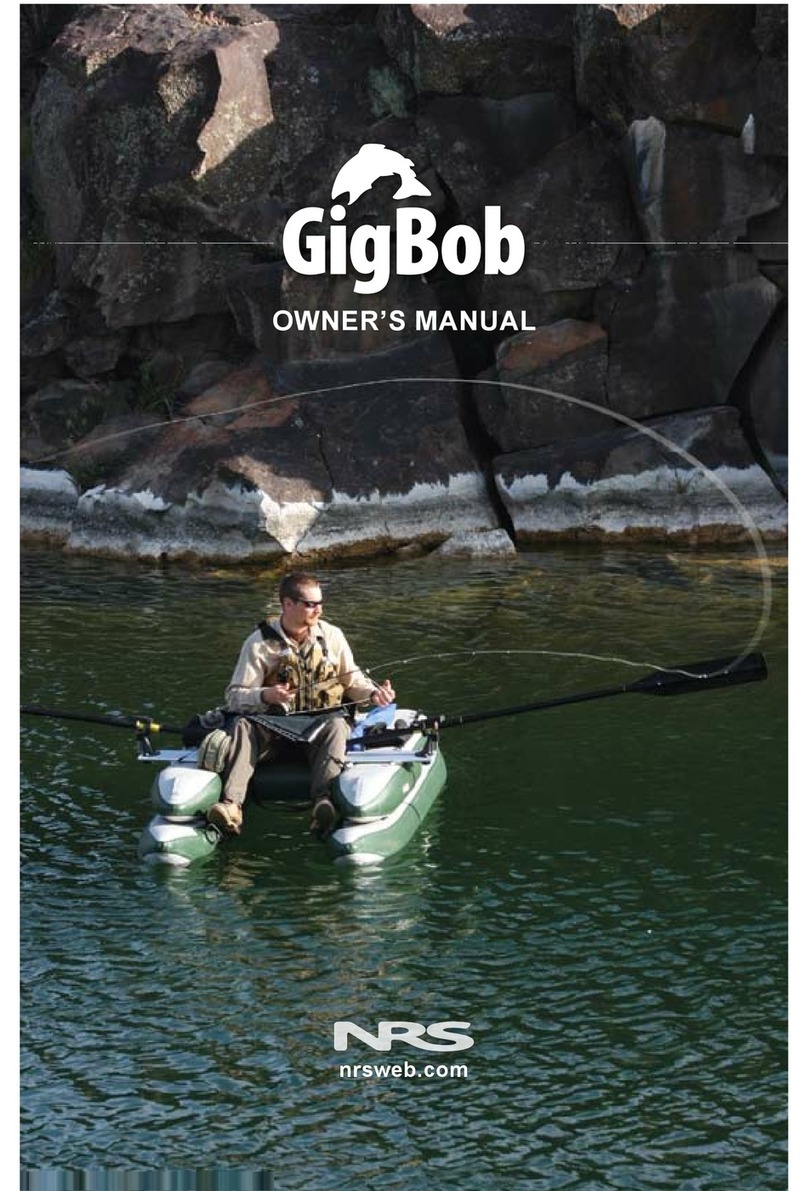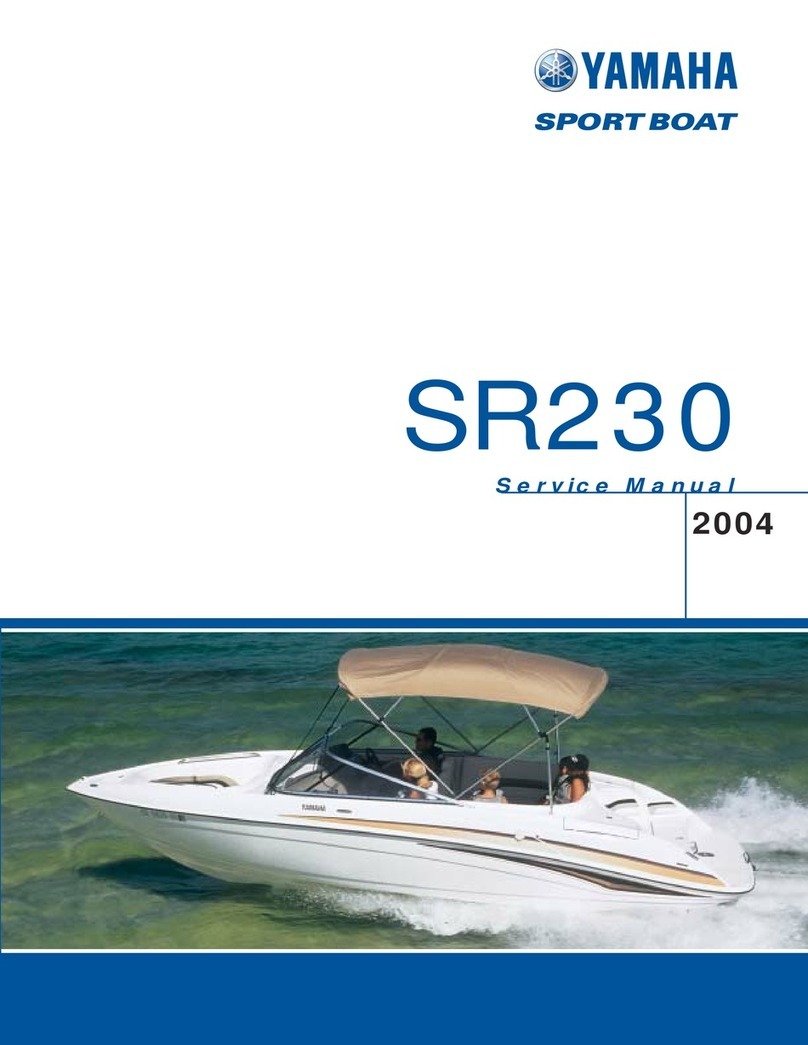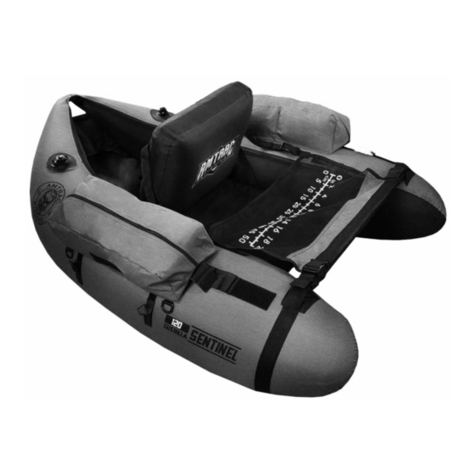C&L Marine Hullabaloo User manual

1
Hullabaloo
47’
Sea
Ranger
Pilothouse
Trawler
Boat name: Hullabaloo (US flagged)
Make/Model/Year: C&L Marine/ 47’ Sea Ranger/1986
Home Port: Anacortes, Washington
USCG registration #: 999965
US Customs (CBP) #: 4541075
Washington Park #: N/A
Chartered thru: Anacortes Yacht Charters
2415 T Avenue, Anacortes, Washington 98221
800.233.3004/360.293.4555

2
Hullabaloo
Table of
Contents
A. Vessel Specifications Page 3
B. Pre-Cruise Page 4
C. Engines Page 4
D. Fuel, Water and Holding Tank Page 6
E. Electronics Page 7
F. Electrical System Page 8
G. Cabin Heat Page 9
H. Head Page 10
I. Galley Page 10
J. Bilge Pumps Page 11
K. Anchoring Page 11
L. Dinghy Page 12
M. Entertainment Page 13
N. Returning to Port & Check in Page 13
O. General Tips Page 14

3
Hullabaloo
Operations Manual
Welcome aboard
Hullabaloo
:
This
manual contains
a
condensed
operating
summary
for this
vessel and its equipment. It is designed to provide a quick reference and answer frequently
asked questions. For more detailed operating and service instructions please refer to the
individual manufacturesmanuals
whichwillbe foundunderthestairs
leading
to theflybridge.
It is important that you familiarize yourself with the proper operations of the vessel and
equipment prior to your departure. Please do not attempt to operate the vessel or any of the
on-board equipmentuntil you are thoroughlyfamiliar with their proper operation.
Do not hesitate to ask any questions pertaining to any aspect of the operation of equipment,
navigation,
or even the best sceneryand fishing holes. Thank you and enjoy your cruising of
the islands.
A. VESSEL SPECIFICATIONS
Construction:
Sea
Ranger
Length: 47’(plus Swim
step)
Beam: 15’2”
Draft: 4’4”
Year Built: 1986
Engines: 2 diesel - Lehman 135 HP
Cruising Speed: 8 KTS. (approx) @ 1800 RPM
Fuel Capacity: 710 gallons
Fuel Consumption: ~6 GPH
Total Fresh Water Capacity: 280 Gallons
Holding Tank Capacity: 80 Gallons
Generator: Onan 12.5 KW Onan
Inverter: 2800 watt
Depth Sounder 2 - Raymarine
VHF Radio: 2 –ICOM IC-M602 (lower helm)
Standard Horizon Apelco (upper helm)
GPS: Garmin GPS Map 4212 (lower helm)
Garmin GPS Map 541s (upper helm)
Dinghy: Bull Frog with 9.9 HP outboard
Stove and Oven: Propane
Microwave: AC shore or
Inverter
Refrigerator:
AC shore or
Inverter
Ice Maker: AC shore or
Inverter
Heat:
Webasto hydronic
diesel heater

4
B. PRE-CRUISE PREPARATIONS
Prior to starting engine for departure, a pre-voyage inspection of the vessel for sea
worthiness, and stowing of all loose items should be made. The “check in / check out”
inspection should identify any obvious items of concern; however, the charter skipper must
take on full responsibility for checking the equipment on the vessel on a regular basis
throughoutthe cruise.
Before each daily startup of the engine, the crankcase oil, coolant, and levels must be
checked. A visual inspection of engine room equipment and bilge, checking for excessive
belt wear, leaks, loose fittings, safety guards, etc., should be performed. Pay particular
attention that the valves to the sea water supply to the engines are open and sea strainers
are clear of debris. Check battery and battery cables for tightness or chafe. Use your nose
to smell the engine compartmentfor any sign of fumes. If fumes are detected, ascertain the
source and correct the problem if possible. Run the blower or open hatches to help clear
fumesfrom engine compartmentbefore starting engine.
C. ENGINES
Access to engine room is through the main salon cabin sole and the Captain’s cabin aft
bulkhead.
PRIOR TO ENGINE STARTING:
Check the engine oil and engine coolant. These need to be done daily. The same
procedureshould be followed with the gen set.
Engine Oil: Delco 400 15W 40
GeneratorOil: Delco 30 W
Transmission ATF
STARTING THE
ENGINES:
•
Check to see that gears (black) are in neutraland throttles (red) are retarded.
•
Start one engine at a time.
o Turn on key (low oil pressure alarm will sound).
o Push starter button (alarm willstop when engine starts).
•
Check oil pressure gauges.
o Theyshould read
approximately
40 pounds.
•
Check engine exhausts to be sure water is flowing from exhaust outlets.
•
Check voltmeter and AMP meter gauges
•
Allow engines to warm at idle for 5 minutes before departure.
Always have throttle (red) in idle position before shifting.
Pause momentarilyat neutral position when shifting from forward to reverse and
vice versa.

5
STOPPING THE
ENGINES:
•
Push red stop button.
•
After engine shuts down turn off the key.
GETTING UNDERWAY / SHIFTING:
•
Always have throttle (red) in idle position before shifting.
•
Hesitate momentarily at neutral position when shifting from forward to reverse and
vice versa.
•
Once underway stow fenders and ensure dock lines are secured
WARNING: Never shift the
transmission
without first throttling the engine back, failure
to throttle back could result in damage to the
transmission.
ENGINE
OVERHEATING:
1. Slow down and shut down the engine that has over heated.
2. If coolant reservoiris at proper level, check engine sea strainerfound forward on
both engines.
3. Before removing the top of sea strainer close thru hull valve to the sea
strainer.
4. Slowlyunscrew the wing nuts on the top of the sea strainer remove top and pull
basket out for better access. Clean debris in the strainer basket.
5. Once the sea straineris free of debris, replace basket, secure top and tighten down
the wing nuts.
6. Open thru hull valve to the sea strainer slowly and check for leakage. If
leakage occurs close thru hull value and repeat step 6 and reopen thru hull valve.
7. After a check of engine
compartments
and engine oil levels restart engine.
8. Check for exhaust water flow.
Drifting debris
is
extremely common
and some of theseare large
enough
to do
major
damage
to moving boats. Always use extreme caution while underway and be constantly alert for
drifting debris and charted and unchartedrocks just belowthe surface. “Dead Heads”, large
water soaked logs floatingjust below the surface are quite common in this area.
Do Not Open Front Window. Please take down Flybridge Canvas
Most accidents occur during times of low visibility. Do not travel at night, in the fog
or stormy weather.
ALCOHOL OR DRUGS DO NOT MIX - NEVER DRINK AND DRIVE!!!

6
D. FUEL, WATER and the HOLDING TANK
Fill caps are clearly stamped/marked:
•
Diesel fills (2) are midship on the port and starboard side decks.
•
Waterfills (2) are also midship aft on port and starboardside decks.
•
Waste outlet is on the port side/stern (cockpit area).
•
Key for fill caps is located in a settee drawer in the salon
Never fill the water and fuel tanks at the same time!
•
Take strict precautionsto avoid allowing water or fuel to enter the wrong tank.
DO NOT REMOVE ANYCAP UNTIL YOU ARE READY TO FILL THAT TANK.
Fuel:
•
Fuel level is checked by sight tubes on individual tanks port and starboard in the
engine room. Open top and bottom sight tube valves to check proper fuel level.
•
ALWAYS FILL FUEL TANKS WITH CLEAN DIESEL ONLY.
•
To avoid spills and/or overfillingof the fuel tanks, listencarefully to the sound of the
fuel entering the tank. There will be a subtle yet noticeable change in the pitch of
the sound as the tank is nearing full. Fill the remainderof the tank cautiously
because the penaltyfor dischargeof oil into navigable waters is costly.
•
Always have oil soaks or rags close by while fueling too immediatelyand thoroughly
clean up any inadvertentspills or overflow.
•
After replacingthe fill cap clean any spilled fuel from the deck with soap and water.
•
Always close top and bottom sight tube valves after checking fuel level.
The fuel shut off valve is on the fuel management panel located aft of the generator in the
engine room.
WATER
SY
STEM:
Hullabaloo carries
approximately
280 gallons of fresh water. Both tanks are on line. Fill
whenever possible. Sight tubes are on each water tank located port and starboard in the
engine room.
WATER
HEAT
ER:
The water hears from AC supplied by shore power or generator as well as the Webasto
diesel heater. The water also heats from the engines while underway, but the switch on the
starboard side at the back of the salon must be on Engine Heat.
HOLDING TANK:
After pumping out, add some water to tank and pump that out to help clean tank.
Holding tank treatment should be added to the tank after it is emptied. See bottle for
instructions.

7
E.
ELECTRONICS
The main breakerfor the electronicsis located on the DC panel.
VHF RADI
O
There are two fixed VHF radios aboard. One is in the wheel house and the other on the fly
bridge. Please refer to Marine
Communication
brochure for proper use of marine VHF radio.
AYC monitorschannel16 and will ask you to switch to channel68 as their working channel.
It is vital that everyone on board is able to perform an emergency call to the
Coast
Guard,
(channel 16) and be able to give an approximate position and description of
the
vessel.
DEPTH SOUNDER
There are two depth sounders on board. One is located in the wheel house and a second
on the fly bridge. Piloting should always be with accurate charts.
Remember
that Hullabaloo
draws over 4½ feet of water and be sure you allow for tide changes.
GPS
PLOTTER
Hullabaloo is equipped with a Garmin GPSMAP 4212 (pilothouse) and a Garmin GPSMAP
541s(upper
helm/flybridge).
The systemsincludecurrentnavigationchartsforPugetSound,
the San Juan Islands and British Columbia.
The GPSMAP 4212 in the pilothouse has radar and sonar.
Please refer to the manufacture’s operating manual for instruction in the use of this
equipment.

8
F. ELECTRICAL SYSTEM
DC SYSTEM (12 VOLT
BA
TTERIES)
This system powers lights, pumps, electronics, anchor windlass and engine start. There are
two banks of batteries forward in the engine room, the portside bank is engine start batteries
and the starboardside bank is house and inverterbatteries.
There are three battery selector switches one in the wheel house and two forward in the
engine room.
The red selector switch located on the forward bulkhead in the engine room marked “MAIN”
should be left in the “ON” position. (i.e. house bank).
A red selector switch located on the forward bulk head in the engine room marked “inverter”
is the inverter switch and should be left in the “ON” position again to save your engine start
bank.
The red main generatorDC switch is also on the forward engine room bulkhead and marked
“Generator.”This switch should be left in the “ON” position in order to be able to start the
generator.
The engine start selector switch is located on the engine room forward bulkhead; this switch
should be left in the “BOTH” position.
In the event of dead start batteries:
The engine start selector switch can be placed in the both position tying the house, inverter
and engine start battery’s together providing the additional power needed to start the
engines. Once the engines have started switch back to position #2.
The engine start bank located on the portside consists of two 4D batteries. The house and
inverter
bank
located
on the
starboard
side
consist
of 8 - 6 volt batteries. The
generator
batter
is also a 4D battery located starboard side aft. The main cabin lights operate from the AC
breakermarked “Cabin Outlets.”
GENERAT
O
R
•
Prior to starting the generator turneverythingoff on the AC panel.
o On the AC panel, switch shore power off and generatorOn
•
To start generator:
Hold down Preheat toggle. Preheat 30 seconds
Depress both start and pre heat toggles to start
.
•
Once the generatorstarts
o Release both switches
o Turn on the desired equipmentto be used on the AC panel.

9
•
Prior to shutting down the generator turn everythingoff on the AC panel.
o Pushthe
preheat
switchUP to the stop
position
andholdtillthe
generator
shuts
down.
•
The generatorsea strainer is located aft and to starboard of the generator.
•
Generatorover heating should be handled the same as the main engine, see Section
C - Engine.
INVE
RTER
Magnum inverter/ charger. Inverter breaker on the DC panel needs to be
on to charge.
Hullabaloo is equipped with a 2500 watt inverter that converts DC electrical power to AC in
limited amounts. The inverter charges its own battery when operatingon shore power or the
generator.
•
The microwave,refrigerator,ice maker and AC plugs will all work off the inverter.
•
The microwaveisfor light duty cookingonly,such as warming or makingpopcorn.
•
The AC plugs can be used for charging your cell phone battery or operating an AC
radio, etc.
•
Never use the AC plugs off the inverter to operate an electric heater or hair
dryer. They will run down the inverter battery very
quickly.
There is a link 2000 inverter controllerdual batterymonitor in the wheel house on the port
side. Please refer to the manufacture’s operatingmanualfor instruction.
G. CABIN HEAT
Hullabaloo cabin heat is provided by a Webasto hydronic diesel heater. The heater is
controlled by a switch in the salon, starboard side below the TV. There are 2 positions for
different operating modes:
When NOT cruising: Up position turns the diesel heater on and runs independently. The
heater will also heat the hot water tank.
When cruising: Down position should be used when cruising. The system will circulate hot
water via the engines rather than the diesel heater. This will also heat the hot water tank.
Cabin controls: Each cabin has a separate thermostat. Increase or decrease the
temperature for each as desired, or they may be switched off. The heads each have a fan,
but the system must be running for them to provide heat (i.e. fans can be turned
on
whether
or not hot water is circulating through the system).
Pilothouse defroster/defogger: The pilot house is set up with a defroster/defogger for
clearing the windows. The switch is located on the small panel on the port side of the
wheel. The fan control is located up on the port side of the instrument panel.
Flybridge: Heat is also available in the flybridge, but the switch for the defroster (in
pilothouse) must be on.

10
H. HEAD
There are three head’s on Hullabaloo all with vacuflush toilets. Remember vacuflush toilets
use fresh water from your water tanks.
Marine heads are complicated mechanisms and the smallest of items can plug the head or
the accompanyingsystems. Even a match stick or a wad of hair can cause problems.
NEVER
place
anything
in the head that has not first been
consumed,
except for a small
amount of MARINE grade toilet paper.
Do not place ANY foreign material into toilet including feminine products, make up
tissue, paper towels, cotton balls, baby wipes, non-marine grade toilet paper. These
items can clog or damage system requiring costly repairs.
The pumps and other related equipment for the vacuflush toilets are located in the stern
lazarette. The macerator pump and thru hull value for pumping overboard are also located
in the stern lazarette. The switch for the macerator pump is located on the DC panel in the
wheel house. The switch should stay in the Off position unless it is being used. Valve
in lazarette must be opened BEFORE turning switch on.
Even though the vessel is equipped with macerator and overboard pumps, it is ILLEGAL to
pump wastewater in the US. To discharge the Waste Water Holding Tank in a LEGAL
discharge area you need to be in Canadian waters, except in no-discharge zones. Always
check local and federal regulations before discharging.
•
The switch for the macerator pump is on the fuse panel below the lower helm.
•
Activate the switch and listen to the sound of the pitch.
•
When the holding tank is empty the sound of the pump will change. Never operate
macerator when the tank is empty.
Holding tank treatment should be added to the tank after it is emptied. See bottle for
instructions.
I. GALLEY
RANGE
Hullabaloo has a Force 10 propane range with oven with igniters. The main breaker is on
the DC panel. The gas switch in located on a panel over the left side of the stove.
To light, push oven knob (far right knob) in and turn desired burner knob or the oven knob
to light position. Hold in until lit and then turn to desired setting before releasing.

11
MICROWAVE
The microwaveoperatesoff shore power, the generatoror the inverter. The main breakeris
on the AC panel marked “Cabin Outlets.”Leave this breaker in the “ON” position.
REFRIGERATOR
& ICE
MAKER
Both units operate by shore power, the generator or the inverter; however, it is not
recommended that they be operated off the inverter. The refrigerator operates off the
breaker on the main AC panelmarked
“Microwave”
or the DC breakermarked“Refrigerator.”
The icemakeroperatesoff the AC breaker marked “Cabin Outlets.”
J. BILGE PUMP
There are two bilge pumps located fore and aft of the engine room. The control is to the left
oftheDC electricalpanel in the wheelhouse. It shouldalwaysbe left in the auto position.
There is a sump pump under the floor deck in the forward cabin. The switch on the DC
electrical panel should be left on.
K. ANCHORING
Hullabaloo has a main and stern or spare anchor and rode. The main is
approximately
a 60
lb. Bruce with 290 feet of 3/8”chain. There is a 45 lb. CQR spare anchor on the bow and 200’
of ¾“ line stored in the lazarette.
The main anchor rode has white painted markers every 25 feet plus color tabs:
•
25 feet –Red
•
50 and 75 feet –Blue
•
100, 125, 150 and 175 feet –Green
•
200 and 225 –Yellow
•
250 –Yellow and Red
•
275 - Red
NOTE: Take care when anchoring. Keep fingers, shoe laces, drawstrings, loose
clothing or long hair clear of anchor, chain, line, and rollers.
To operate the anchor windlass:
•
Keep engines running while setting anchor.
•
The anchorwindlass switch is on the electricpanel in the wheelhouse- largered knob
in lower left. It must be in the on position.
•
Two foot pedals at the windlass raise and lower the anchor

12
•
The anchor rode may also be played out manually by releasing the break on the
windlass with the winch handle located at the anchor windlass or power down.
Use care to note depth of water and the stage of the tide. Anchoring in shallow water
on a high tide can lead to being left high and dry on a rocky bottom when the tidal level
falls. Be sure to note your
surroundings
and any possible
hazards
or obstacles which
the vessel may swing into if the wind or
currents
change
direction.
Inspect all shackles and hardware for proper tightness. Inspect chain and line for excessive
wear or frayingprior to
setting
anchor. It is advised that the
position
of the boat and the depth
of the water be checked frequently, and the boat not be left unattended while anchored for
long periods of time.
Anchor bridle: Once sufficient rode has been deployed, set up anchor bridle.
•
Run line under bow pulpit
•
Place hook on the anchor rode
•
Run lines through port and starboard hawse pipes and tie off on stanchions
•
Play out additional rode to put tension on bridle
•
Use short line and hook on rode at windlass (hook on chain and tie off on windlass)
Recovering anchor:
•
Engines should be running while operating windlass.
•
Use care not to damage windlass or anchor platform by placing excess stress.
•
Wash down (saltwater) is to the port side of the windlass. Rinse rode to remove
mud as it is being retrieved. This will keep it (and the odor) out of the anchor locker
which is below deck in a forward compartment in the forward stateroom.
o The switch is on a small panel to the right of the main DC
panel.
•
Once anchor has been recovered, use small line and chain hook to secure anchor
to cleat on windlass. This will take tension off the windlass and protect against
accidental release of anchor.
L. DINGHY
The dinghy, the ‘Loo Too is a hard bottom 10’Bull Frog with a 9.9 HP Honda 4-stroke
outboard. It is provided for transportation to the dock whenmoored or anchored out and for
fishing. Please USE CAUTION WHEN BEACING on gravel, rocks and barnacles as they
can damage the bottom.
•
The dinghy can be lowered to the water with the davit.
•
The switch for the davit on the electricalpanel (same switch as AnchorWindlass).
•
The controls for the davit are on the motor itself
•
BE SURE PLUG IS IN THE TRANSOM DRAIN.
Check Oil Level before starting Oil separate Oil Reservoir

13
M.
ENTERTAINMENT
TV & MOVIE
An HD TV and Blu-Ray player are provided for your enjoyment. There is also an HDMI
adapter you may use to connect your computer to the Blu-Ray player.
A variety of movies are located in the drawer under the TV.
Stereo
Hullabaloohas an Alpine stereo receivermounted on the fly bridgestairway.An iPod/iPhone
cable is in the compartment next to it. Turn on the Accessory switch on the DC panel.
SiriusXM satellite radio is also available. A copy of the program listing is under the speaker
control box.
Speakers are located throughout the boat and can be switched via the controller. The
switches are labeled (the speakers in the forward and mid-cabin on a single switch).
N. RETURNING TO PORT & CHECK IN:
Upon returningto port for Check-In you need to:
•
Top off the fuel (2 fill port - starboard and port on steps of walk-around)
•
Fill water tanks (2 fill ports - starboard and port, aft area of walk-around)
•
Empty the holdingtank (see Section D)
DOCKING
PROCEDURES
Wheneverpreparing
todock,beginearly
soyouare
notrushedand
possibly
forgetsomething
important:
•
Determine as far in advance as possible on which side of the vessel you will be
docking and prepare accordingly.
•
Hang four fenders per side at the appropriateheight and location.
•
Place lines at the cleats on the appropriateside, locate and prepareboat hook.
•
Alert crew and have them in position to assist you.
•
Stow loose gear so as too not hinder moving about the boat.
•
Always approach the docking facilities or moorage as slowly as is possible, while
maintaining maneuverability.
•
Secure the boat with proper forward, aft, and spring lines as necessary to allow the
vessel to ride easily and securelywhile moored.
•
Connect shore power cord to boat and shore connection.
•
Switch from DC to AC (Shore) on Main Panel

14
O. GENERAL TIPS
Taking proper care of Hullabaloo helps ensure her continued availability for your next Pacific
Northwest adventure. If you have any concerns or feel something needs to be addressed
please advise your Check-In host.
•
Extra storage is located under the settees in the salon.
•
Never use countertopsfor cutting, please always use the cutting board.
•
Please keep things tidy and return anythingyou use to its proper place.
•
Please refrain from smoking in or on vessel. Thank you for your cooperation.
•
Check shoes and feet for beach tar and creosote from dock or use slippers while on
the boat.
Table of contents
